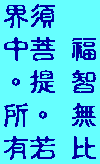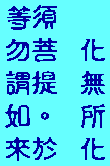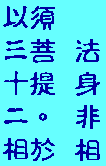CONTENTS
Commentary on Chapter 24 "Blessings
and Wisdom Beyond Compare"
 "Subhuti, if there were heaps of the seven precious gems equal in
amount to all the Sumerus, Kings of Mountains, in three thousand
great thousand world systems, and someone gave them as a gift, and
if some else were to take from this Prajna Paramita Sutra as few as
four lines of verse, an d receive, hold, read, recite, and speak them
for others, his blessings and virtue would surpass the previous one's
by more hundreds of thousands of millions of billions of times than
either calculation of analogy could express."
"Subhuti, if there were heaps of the seven precious gems equal in
amount to all the Sumerus, Kings of Mountains, in three thousand
great thousand world systems, and someone gave them as a gift, and
if some else were to take from this Prajna Paramita Sutra as few as
four lines of verse, an d receive, hold, read, recite, and speak them
for others, his blessings and virtue would surpass the previous one's
by more hundreds of thousands of millions of billions of times than
either calculation of analogy could express."
Sumeru is a Sanskrit word which means "wonderfully high".
The Dharma from this Prajna-Paramita Sutra is the unsurpassed one. To practise it as few as four lines of verses, and receive, hold, read, recite and speak them for others, the blessing and virtues is also unsurpassed.
The Diamond Sutra expresses the importance of not attaching to any mark. As the Prajna relinquishes all marks, the virtues are uncountable and unsurpassed. If we practise giving with the attachment to mark and to the desire for our own gain, our resulting virtue is countable and limited.
Commentary on Chapter 25 "Transformations
without what is Transformed"
Shakyamuni Buddha said, "You, Sound-Hearers, do not say that the Tathagata has the thought, 'I shall rescue living beings' Why? There actually are no living beings taken across by the Tathagata. The Tathagata and living beings are one. Therefore the Tathagata rescues living beings without there being any living beings rescued. The Tathagata does not take living beings across: they take themselves across.
 "Subhuti, what do you think? You should not maintain that the
Tathagata has this thought: 'I shall take living beings across.'
Subhuti, do not have that thought. And why? There actually are
no living beings taken a cross by the Tathagata. If there were
living beings taken across by the Tathagata, then the Tathagata
would have the existence of a self, of others, of living beings,
and of a life. Subhuti, the existence of a self spoken of by the
Tathagata is no existence of a self, but common people take it as
the existence of a self. Subhuti, common people are spoken of by
the Tathagata as no common people, therefore they are called common people."
"Subhuti, what do you think? You should not maintain that the
Tathagata has this thought: 'I shall take living beings across.'
Subhuti, do not have that thought. And why? There actually are
no living beings taken a cross by the Tathagata. If there were
living beings taken across by the Tathagata, then the Tathagata
would have the existence of a self, of others, of living beings,
and of a life. Subhuti, the existence of a self spoken of by the
Tathagata is no existence of a self, but common people take it as
the existence of a self. Subhuti, common people are spoken of by
the Tathagata as no common people, therefore they are called common people."
The Sixth Patriarch said to the Fifth Patriarch, "When one is deluded, one's Master takes one across; but when one is enlightened, one takes oneself across." Once we understand, we take ourselves across. When living beings are confused, the Buddha takes them across. Living beings need to wake up, but who wakes them up? It is not the Buddha; they wake up themselves. In other words, "In the equality of the true Dharma realm, the Buddha does not take living beings across." Living beings and the Buddha are equal. There is not a little more of something on the part of a Buddha, or a little less of something on the part of living beings. Because of that it is said, "There actually are no living beings taken across by the Tathagata."
If we insisted upon saying that there were living beings taken across by the Tathagata, then the Tathagata would have the existence of a self, of others, of living beings, and of a life, and the four marks would not be empty. The Buddha tells all living beings to leave all marks. How much the more so must the Buddha himself have done so. So when the Buddha rescues living beings, it is really the living beings who rescue themselves. The Buddha does not take living beings across, because he has no mark of self.
Subhuti, the existence of a self spoken of by the Tathagata is no existence of a self, the existence of self refers to the false self... Is no existence of self means it is not the true self. Common people take the false self as true, but common people are spoken of by the Tathagata as no common people, therefore they are called common people. Subhuti, those who are presently common people will eventually realize Buddhahood, so the Tathagata says they are not common people. We must not look upon them as ordinary. The Buddha said that all living beings have the Buddhanature, all can become Buddhas. It is only because of false thinking and attachment that they have not yet been able to certify to Buddhahood. The Buddha regards all living beings as his former fathers and mothers and as future Buddhas. Common people are just called common people, because that is what they are right now.
Commentary on Chapter 26 "The Dharma
Body Has No Marks"
Subhuti said, "So it is , so it is,
World Honored One. One can contemplate the Tathagata by means of
the thirty-two marks."
The Buddha said, "Subhuti, if one could contemplate the Tathagata
by means of the thirty-two marks, then a Sagely Wheel-turning King
would be a Tathagata."
Subhuti said to the Buddha, "World Honored One, as I understand what
the Buddha has said, one should not contemplate the Tathagata by
means of the thirty-two marks."
At that time the World Honored One spoke a gatha which says,
 "Subhuti, what do you think? Can one contemplate the Tath
agata by means of the thirty-two marks?"
"Subhuti, what do you think? Can one contemplate the Tath
agata by means of the thirty-two marks?"
If one sees me in forms,
If one seeks me in sounds,
He practices a deviant way,
And cannot see the Tathagata.
Shakyamuni Buddha asked Subhuti, "Can one contemplate the Tathagata merely by means of the thirty-two marks?" Previously the Buddha had asked Subhuti if one could "see" the Tathagata by means of the thirty-two marks. Then at this point he asked if one could contemplate the Tathagata by means of them. Seeing is a function of the eyes, whereas contemplation is a function of the mind. Subhuti was entangled in that distinction, and so he replied, "Yes, one can contemplate the Tathagata's Dharma body by means of the thirty-two marks."
But the Buddha pointed out that a Sagely Wheel-turning King also possesses the thirty-two marks, and so he too should be a Buddha. Actually, a Wheel-turning King's thirty-two marks are slightly less distinct than a Buddha's. People with the Five Eyes and Six Spiritual Penetrations can distinguish the difference. But since ordinary people cannot, to say that ordinary people can see the Tathagata by means of the thirty-two marks means that they would also see a Wheel-turning King as a Buddha.
After Subhuti heard the Buddha's explanation he replied, "As I understand what the Buddha has said, one cannot see or contemplate the Tathagata by means of the thirty-two marks."
Shakyamuni Buddha then spoke a verse for Subhuti:
If one sees me in form means there may be people who see the thirty-two physical marks and think they are seeing the Buddha himself.
If one seeks me in sound means there may be those who take the Four Eloquences and the Eight Sounds as being the Tathagata.
He practises a deviant way/and cannot see the Tathagata. The deviant path of grasping at the sight or the sound of the Buddha leads one into the extreme of clinging to conditioned existence. When one is not in accord with the Middle Way, one cannot see the Tathagata. The Avatamsaka Sutra says: "Response and transformations are not the true Buddha." The thirty-two marks belong to the response and transformation bodies, and certainly not to the Buddha's Dharma body. One who holds to annihilationism views everything as doomed to extinction. One who holds to permanence views every thing as eternal. Both views are biased and not the Middle Way. If one seeks the Tathagata's Dharma body by some path other than the Middle Way, it will be impossible to find it.